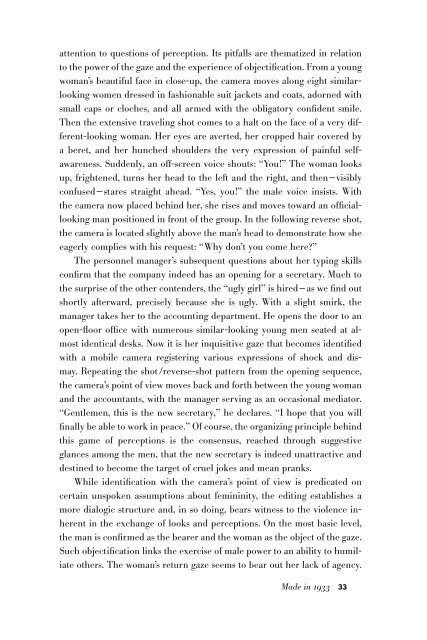Create successful ePaper yourself
Turn your PDF publications into a flip-book with our unique Google optimized e-Paper software.
attention to questions of perception. Its pitfalls are thematized in relation<br />
to the power of the gaze and the experience of objectification. From a young<br />
woman’s beautiful face in close-up, the camera moves along eight similarlooking<br />
women dressed in fashionable suit jackets and coats, adorned with<br />
small caps or cloches, and all armed with the obligatory confident smile.<br />
Then the extensive traveling shot comes to a halt on the face of a very different-looking<br />
woman. Her eyes are averted, her cropped hair covered by<br />
a beret, and her hunched shoulders the very expression of painful selfawareness.<br />
Suddenly, an off-screen voice shouts: “You!” The woman looks<br />
up, frightened, turns her head to the left and the right, and then—visibly<br />
confused—stares straight ahead. “Yes, you!” the male voice insists. With<br />
the camera now placed behind her, she rises and moves toward an officiallooking<br />
man positioned in front of the group. In the following reverse shot,<br />
the camera is located slightly above the man’s head to demonstrate how she<br />
eagerly complies with his request: “Why don’t you come here?”<br />
The personnel manager’s subsequent questions about her typing skills<br />
confirm that the company indeed has an opening for a secretary. Much to<br />
the surprise of the other contenders, the “ugly girl” is hired—as we find out<br />
shortly afterward, precisely because she is ugly. With a slight smirk, the<br />
manager takes her to the accounting department. He opens the door to an<br />
open-floor office with numerous similar-looking young men seated at almost<br />
identical desks. Now it is her inquisitive gaze that becomes identified<br />
with a mobile camera registering various expressions of shock and dismay.<br />
Repeating the shot /reverse-shot pattern from the opening sequence,<br />
the camera’s point of view moves back and forth between the young woman<br />
and the accountants, with the manager serving as an occasional mediator.<br />
“Gentlemen, this is the new secretary,” he declares. “I hope that you will<br />
finally be able to work in peace.” Of course, the organizing principle behind<br />
this game of perceptions is the consensus, reached through suggestive<br />
glances among the men, that the new secretary is indeed unattractive and<br />
destined to become the target of cruel jokes and mean pranks.<br />
While identification with the camera’s point of view is predicated on<br />
certain unspoken assumptions about femininity, the editing establishes a<br />
more dialogic structure and, in so doing, bears witness to the violence inherent<br />
in the exchange of looks and perceptions. On the most basic level,<br />
the man is confirmed as the bearer and the woman as the object of the gaze.<br />
Such objectification links the exercise of male power to an ability to humiliate<br />
others. The woman’s return gaze seems to bear out her lack of agency.<br />
Made in 1933 33

















